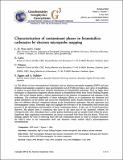Por favor, use este identificador para citar o enlazar a este item:
http://hdl.handle.net/10261/25620COMPARTIR / EXPORTAR:
 SHARE SHARE
 CORE
BASE CORE
BASE
|
|
| Visualizar otros formatos: MARC | Dublin Core | RDF | ORE | MODS | METS | DIDL | DATACITE | |

| Título: | Characterization of contaminant phases in foraminifera carbonates by electron microprobe mapping |
Autor: | Pena, Leopoldo D.; Cacho, Isabel; Calvo, Eva María CSIC ORCID ; Pelejero, Carles CSIC ORCID ; Eggins, S.; Sadekov, Aleksey | Palabras clave: | Foraminifera Mg/Ca Ocean drilling program Electron microprobe Laser ablation Calcium carbonates Mg Ca |
Fecha de publicación: | 15-jul-2008 | Editor: | American Geophysical Union | Citación: | Geochemistry, Geophysics, Geosystems 9(7): Q07012 (2008) | Resumen: | The advent of new microanalytical techniques such as electron microprobe mapping (EMP) and laser ablation microsamplers coupled to mass spectrometers (LA-ICP-MS) provides a new array of possibilities to explore in great detail the trace elements distribution in foraminiferal carbonates. Here we apply these techniques to characterize diagenetic phases present in foraminiferal shells from Ocean Drilling Program Site 1240 in the Panama Basin, a region characterized by the presence of manganese-rich minerals in the sediments. The combined application of these techniques allows us to characterize the elemental and spatial distribution on the surface and across the foraminiferal shells. Results illustrate the presence of at least two different Mn-rich contaminant phases in the foraminiferal carbonates: Mn-rich carbonates and ferromanganese oxides. Elemental maps also highlight the relevance of the foraminifera shell texture and porosity in the distribution and formation of these contaminant phases. In the case of Neogloboquadrina dutertrei, Mn phases form a continuous thin layer in the inner part of the chambers, whereas for Globigerinoides ruber, Mn phases have a rather patchy distribution and are usually found within the pores. Significant high magnesium concentrations are always associated with these Mn-rich phases. These new findings support the need of removing these Mn-rich contaminant phases in order to measure accurately the Mg/Ca ratios in the foraminifera shell and therefore obtain reliable Mg/Ca paleotemperature reconstructions | Descripción: | 13 pages, 4 figures, 1 table | Versión del editor: | https://doi.org/10.1029/2008GC002018 | URI: | http://hdl.handle.net/10261/25620 | DOI: | 10.1029/2008GC002018 | ISSN: | 1525-2027 |
| Aparece en las colecciones: | (ICM) Artículos |
Ficheros en este ítem:
| Fichero | Descripción | Tamaño | Formato | |
|---|---|---|---|---|
| Pena_et_al_2008.pdf | 1,22 MB | Adobe PDF |  Visualizar/Abrir |
CORE Recommender
SCOPUSTM
Citations
70
checked on 20-abr-2024
WEB OF SCIENCETM
Citations
69
checked on 23-feb-2024
Page view(s)
479
checked on 24-abr-2024
Download(s)
238
checked on 24-abr-2024
Google ScholarTM
Check
Altmetric
Altmetric
NOTA: Los ítems de Digital.CSIC están protegidos por copyright, con todos los derechos reservados, a menos que se indique lo contrario.
